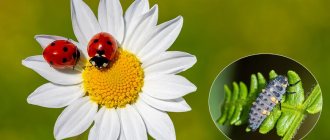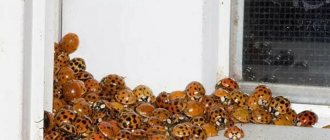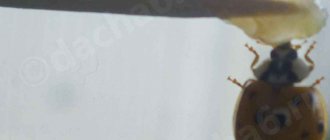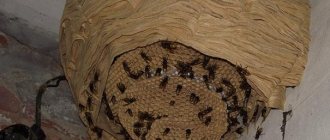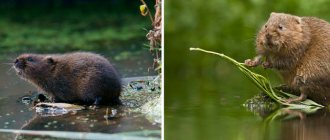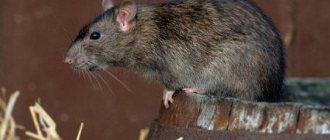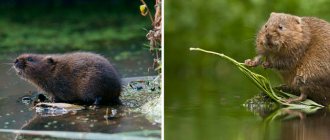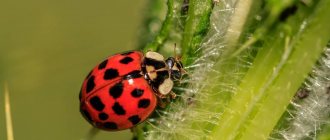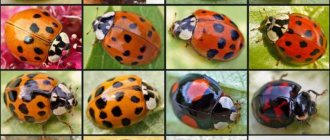The ladybug is a small, brightly colored bug that is familiar to everyone. The red back with black dots attracts the attention of adults and children when the insect crawls along a green leaf. In addition to its charming appearance, pleasing to the eye, the insect has a quality that benefits people - this predatory creature destroys insect pests in household plots and vegetable gardens.
So some summer residents breed ladybugs at home, then plant them in the garden to control pests without the use of chemicals, using environmentally friendly methods.
Ladybug habitat
Ladybugs are distributed almost throughout the planet, with the exception of the permafrost zone and Antarctica. According to different biological classifications, researchers identify from 6 to 8 thousand species of ladybugs. They are not only red with black dots, but also vice versa. There are yellow, white, blue and even black beetles. There may be 2 points, several or none at all.
They live on trees and bushes, in the grass. They are active in the cool morning or evening hours.
In nature
In temperate latitudes, ladybugs overwinter:
- in the roots of trees;
- in piles of fallen leaves;
- in cracks under the bark of trees;
- in holes under stones;
- under the top layer of soil.
At the same time, the insects cluster together. The accumulation of identical individuals allows each to maintain a body temperature higher than in the environment.
On a note! The orange trail that a disturbed ladybug leaves behind is hemolymph, which replaces blood for insects. It is distinguished by bugs from the knee joints. The liquid has a very caustic composition, which makes ladybugs inedible for most insectivorous vertebrate creatures.
Interesting to know
Folklorists believe that the name of the beetle is directly related to the ancient Slavic pagan goddess of agriculture and fertility Mokosh. The flight of an insect from the finger was accompanied by the well-known request for bread (“fly to heaven, bring me bread”) as a symbol of productivity and prosperity. This explains her divinity.
In English-speaking regions it is called Lady bird or Lady beetle. The general word Lady, according to scientists, implies the image of the Virgin Mary, and Catholics consider the insect itself to be the insect of the Virgin Mary.
In a number of world cultures, killing this species is prohibited as they are believed to bring good luck.
Nutrition
The vast majority of ladybugs are entomophagous predators, i.e. they eat insects. The diet includes:
- different types of garden aphids;
- pests from the coccid family: scale insects, scale insects, false scale insects;
- adult individuals and egg clutches of leaf beetles;
- corn moth.
On a note! Some types of ladybugs are herbivorous, while others are even pests of agricultural crops, such as potatoes, melons, beans, and forage grasses.
The mouthparts of ladybugs are of the gnawing type. Their jaws are capable of biting through the integument of insect pests in order to then suck out the nutritious liquid.
One of the distinctive qualities of these creatures is their incredible gluttony. Adult specimens are capable of destroying 100 or more adult aphids per day, while larvae are slightly smaller – up to 70. This quality makes ladybugs the main orderly for agro-industrial territories, private plots, and vegetable gardens.
Reproduction
Discussing the topic “When and how a ladybug reproduces,” it is worth noting that this process occurs from the beginning of March, and one insect mating sometimes lasts up to 9 hours in a row. The female can lay from five to three hundred yellow eggs that have an elongated shape. For laying, she chooses places with a large concentration of aphids, since the number of offspring depends on this.
A week later, the eggs hatch into larvae with well-developed jaws. They are very voracious and eat huge amounts of aphids. The larvae themselves have a disgusting taste, so almost no one hunts them. After another ten to fifteen days, a ladybug pupa emerges from the larva, which attaches to the plant leaves using the remains of the exoskeleton. After another two weeks, during which all the characteristic parts of the body are formed, it turns into a fully formed adult.
A young insect can be recognized by its pale color and lack of pattern. Over time, the back of the ladybug acquires a rich shade, and a corresponding pattern appears on it. In general, the duration of the full cycle of development and transformation is from four to seven weeks.
Why are insects bred?
It is difficult to call ladybugs domestic insects. However, they are often bred for biological control purposes:
- At the end of the warm season, summer residents themselves catch adult insects, leave them for reproduction, and then release them on their own plot next spring;
- for commercial purposes - for sale in private farms and farmsteads.
If you are lucky enough to save a ladybug from freezing in the fall, you can leave it for the winter and release it into the wild next season.
At home, ladybugs are able to actively reproduce. In artificially created conditions, the reproduction process is very active, so the number of insects increases quite quickly. Both fertilized ladybird eggs and healthy mature individuals for individual breeding are suitable for sale.
Homemade
Ladybugs grow quite quickly.
- The female lays 20-40 yellow eggs.
- After a week, larvae emerge from them. Outwardly, they are completely different from adult insects of their species; they can be compared to a crocodile. The larvae have a large head, an elongated spindle-shaped body, and 3 pairs of legs. The colors are bright, repelling predators. Sickle-shaped jaws. The larvae feed on the same types of insects as the adults.
- After a month, the larva pupates.
- An adult insect lives up to 2, rarely up to 3 years.
What are the features of the life cycle of a cow?
The ladybug has an oval-elongated body, flat below and convex above, with inconspicuous hair in some individuals. The size is approximately four to ten millimeters. The head is small with segmented antennae. The insect has six legs with which it moves quickly, and it flies thanks to its two hind wings. The front wings perform a protective function when the ladybug is on the ground.
The color of the insect can be different in configuration with each other:
- bright red;
- yellow;
- Navy blue;
- black;
- brown.
The pattern on the back indicates gender. In total there are about four thousand species of cows, the most famous:
- point-to-point;
- seven-point;
- twelve-point;
- thirteen-point;
- seventeen-point;
Ladybug can have different colors
- blue;
- pointless;
- Asian.
Insects live separately and gather together for mating, wintering or migration. The life cycle of one cow is short, on average up to one year under positive conditions and good nutrition; if there is a lack of diet, it is shortened by a couple of months. To scare away enemies, they use a special liquid that smells strongly and therefore frogs, spiders and other ill-wishers eliminate themselves.
Sexual period occurs between the third and sixth months of life, most often in mid-spring. The partner searches for the female by the smell she gives off. Then mating occurs and she lays eggs near the food source (on the leaves of plants). One clutch can contain up to 400 eggs. After mating games, most females die.
The larvae appear after a week or two; at first they feed on the remains of the egg, and after gaining strength they switch to a normal diet.
Complete pupation occurs after five to seven weeks.
Read on topic:
Features of the life activity of ladybugs
14.11.2020
Description of chironomids and their possible danger to humans
14.11.2020
What do cutworms look like and what harm do they cause?
14.11.2020
What do goliath beetles look like and can they be bred at home?
14.11.2020
What to feed a ladybug at home?
Ladybugs at home can certainly eat the same things as in the wild. However, it is unlikely that it will be possible to provide a large colony of insects with the usual “prey”. That's why ladybugs eat at home:
- sugar and yeast solution;
- steamed raisins;
- white part of the onion;
- an aqueous solution of sugar or honey;
- finely chopped sweet apple;
- jam, marmalade.
The insect is small, but quite voracious and eats a lot. You need to feed the bugs 2 times a day in tiny portions. Food can be given, for example, on the tip of a toothpick.
Houses with bait
Ladybugs need a safe, dry place to escape the cold and lay their eggs. You can build your own shelter for them using a few common items. Take a cardboard roll of paper towel or toilet paper, wrap it with string, tie knots and hang the structure on a fence or on posts in the garden. Place raisins inside - they will attract bugs.
This advice should be used carefully: not only ladybugs can flock to the sweetness.
You can provide safe hiding places for them by covering the ground in and around your garden with mulch or straw. This will provide plenty of little nooks and crannies around the garden for ladybugs to hide from predators.
How to arrange a ladybug's home?
The housing in which the ladybug will spend the winter must protect it from drafts, frost and at the same time overheating, and attacks from pets and children. Suitable for these purposes:
- windowsill;
- gap between window frames;
- barn;
- cellar;
- garage.
The easiest way is to place chopped straw or corn tops at the bottom of a glass jar so that the insect can hide there. Cover the top of the container with gauze to allow fresh air to flow. Place the jar in a cool place, do not shake or move it.
Important! There is absolutely no need to place insects in the freezer. It's too cold there, they'll die.
At home, ladybugs live well in large colonies: adult insects together with larvae, which usually does not happen in nature. However, this is only possible if there is enough food for all individuals.
Care and caution
The ladybug is small (an adult reaches an average of 0.8−1 cm) and fragile, so any attempt to pick it up or play with it can lead to negative consequences. Precautionary and careful measures when caring for a bug are the following:
- It is better to catch the animal with a net.
- In order to take an insect in your hand, you need to place your finger next to it and wait for it to climb onto it.
- The ideal temperature for life and reproduction of Coccinellidae is considered to be +20 ⁰ C, so it is recommended to avoid hypothermia.
Do not forget that your pet is an insect, so after each contact with it it is recommended to wash your hands thoroughly with soap.
Content Rules
Keeping a ladybug at home is not difficult. It doesn’t matter whether you are going to breed insects for sale, or release the foundling into the sky in the spring. Care consists of:
- in organizing housing with shelter;
- availability of food;
- clean water.
Content
Moss can be laid out in the insectarium if it is possible to plant living leafy plants on which the natural prey of bugs, aphids, can breed. Ladybugs need to be cared for in the same way as other insects bred in captivity.
- Do not pick it up with your hands to avoid crushing it.
- Avoid excessive humidity and high temperatures.
- The container should be spacious enough and allow air to pass through.
- In the insectarium, place food (for example, cotton wool soaked in sugar syrup) and containers with water for drinking.
Remember! During the winter, insects hibernate. Ladybugs sleep in captivity, as in natural conditions, buried shallowly in soft, loose litter.
Dual-use exotarium
Bakhcha Ponomarev is located 60 kilometers from Stavropol. There is a regional highway next to his farm, but tourists don’t use it much. Nevertheless, in the melon area, where a brisk trade in watermelons begins in mid-July, the cost of less than a dozen cars is rare. And on weekends, the parking lot nearby is full.
The Ponomarevs have a lot to see - in addition to the already famous straw figures, there is a small zoo with a camel, rabbits, ostrich and smaller birds, as well as an exotarium with ladybugs. But during the day, only moss is visible; in the heat, the insects themselves hide from the scorching sun.
“There are several thousand of them here, they hide during the day and only come out in the morning.” They really liked our conditions. Now ladybugs are actively breeding,” says Roman during a short excursion around the melon patch.
Coccinellids, which is the scientific name for these insects, were collected in the vicinity of the farm. The melon growers did not plan to save money in this way. These beetles simply do not need to be adapted to local conditions; they are already adapted to them.
Caring for them is simple: ladybugs have a sweet tooth, and they are fed with honey. The main source of food is aphids. Plants infected with this pest are placed in an exotarium. Ladybird larvae also feed on aphids.
- This is a natural entomophage. They are predators that eat agricultural pests: aphids, mealybugs and mites. Cows are very unpretentious - they survive even after treating fields with chemical insecticides. At the same time, the costs of their maintenance are minimal,” says Ponomarev. — Now the market price of one insect is about four rubles.
According to him, coccinellids are ideal for protecting greenhouses in winter. The complex with an area of 770 square meters on the territory of the melon plant can protect two thousand insects from pests. That's about a handful of bugs. Of course, if the greenhouses are very large, a small exotarium is not enough; you need to engage in full-fledged breeding of entomophages. For open ground, this method of protection is unlikely to be suitable - the insects will simply fly away.
Now the exotarium with ladybugs is part of the tourism infrastructure, which should attract even more guests to the melon planting
Now the exotarium with ladybugs is part of the tourism infrastructure, which should attract even more guests to the melon planting. However, in parallel, Ponomarev, together with his assistants, is studying the conditions of their maintenance and breeding, as well as the most effective methods of use in pest control. This year no one expects profit from insects, but starting next year, if this direction lives up to expectations, helper beetles will begin to be bred on an industrial scale.
“This is a necessary part of bioproduction, which eliminates the use of chemicals. Three years ago, when I started talking about this with other farmers, especially owners of large enterprises, they only smiled: they say, this is the age of chemistry. But chemicals are expensive, and the consequences of their use can be sad. By the way, now large agricultural businesses use bioinsecticides and biofungicides.
In addition to the ladybug, popularity may also come to lesser-known, but no less useful for farming, habrobracones - insects that immobilize pest larvae and lay their eggs in them. And large enterprises in Russia and abroad have already begun to produce preparations based on mushrooms, which also rid fields and greenhouses of unnecessary insects. - But even here you need to know when to stop. For example, in a preparation based on the bactisubtil culture, after the expiration date, substances are formed that can adversely affect plants. And the same ladybugs, or rather their larvae, in the absence of a food supply, begin to eat crops,” adds Ponomarev. - In any case, this new area needs to be studied. Over time, we will understand all the intricacies.
A comment
Alexey Abaldov, head of the non-profit organization “Union of Biological Farming”:
— Chemicals cannot be used in organic farming. In Russia, since 2022, Law No. 280 has been in force, which regulates this type of agricultural activity. But so far organic production is only a small sector of the agricultural economy. There are many reasons why farmers and large producers are afraid to do it. First of all, this is a lack of domestic experience. The developments that exist in the West cannot be used in our region, since our soils and climate are different.
With this method of work, it is necessary to combat outbreaks of diseases and pests not with pesticides, but with biological methods, but this is difficult for domestic farmers. In addition, in the first years, until the soil microflora is restored, crop yields decrease, and the products lose their marketable appearance. The harvest is reduced by 15-30 percent during this period. Not everyone can afford to do this.
Biologized farming, when agricultural technology combines chemical protection methods with biological ones, is much more accessible. We can, for example, when growing grain crops, replace chemical preparations by 30-40 percent with biological ones and not lose in the quality and quantity of the crop. Moreover, the cost will be reduced and the toxicity of the products will be reduced. It is also worth noting that we have a serious problem with the preservation of beneficial insects and soil microbiota. More than two dozen biofirms operate in the region, and biological products are used on 600 thousand hectares. But this is not enough.
What do these creatures look like?
Even a child can describe a ladybug. It is remembered by its bright color. There are:
- scarlet;
- yellow;
- bronze;
- red;
- cherry;
- brown.
The insect is small in size - up to 10 mm. The shape is convex, round.
The body structure is divided into the following parts:
The latter consists of three sections. These include paws - there are six of them; abdomen and wings with elytra.
These beetles fly using two wings located at the back. The front ones are rigid, their main function is to protect those with the help of which ladybugs fly. They have black dots or spots , depending on their type. These patterns also differentiate the sex of insects.
Create lawns
Yarrow, chamomile, dandelion, cornflower and other wildflowers are very attractive to ladybugs. Therefore, you should not try to mow vegetation in areas unoccupied for beds. Even a small, overgrown lawn can attract these beneficial insects and cause them to stay there for the entire season.
If there is no free piece of land, then you can make a green island on the roof of an outbuilding, for example.
To do this, you should create a bedding from a wooden base, a layer of waterproofing, foil or film, thermal insulation, drainage and soil, and then sow wild flowers and grass there. In the area of the overhang, it is better to build a limiter by nailing a board so that parts of the soil do not slide and water does not drain.
Where did the name come from?
In Latin, in science, ladybugs are called coccineus. Translated, this means scarlet. This is what these creatures were called for their bright colors. People in different countries have come up with all sorts of other nicknames that characterize these insects:
- in Germany - the Virgin Mary beetle;
- in Latin America - St. Antonio's cow;
- in Tajikistan - a red-bearded grandfather;
- in Ukraine, in Belarus - the sun;
- in England - lady bird.
In Russia, according to legend, the first part of the name comes from the fact that in places where there are a large number of these beetles, there is always an excellent harvest. They are called “cows” due to the liquid they secrete, similar to milk - cantharidin. It is poisonous to insects, which saves the lives of ladybugs in times of danger.
